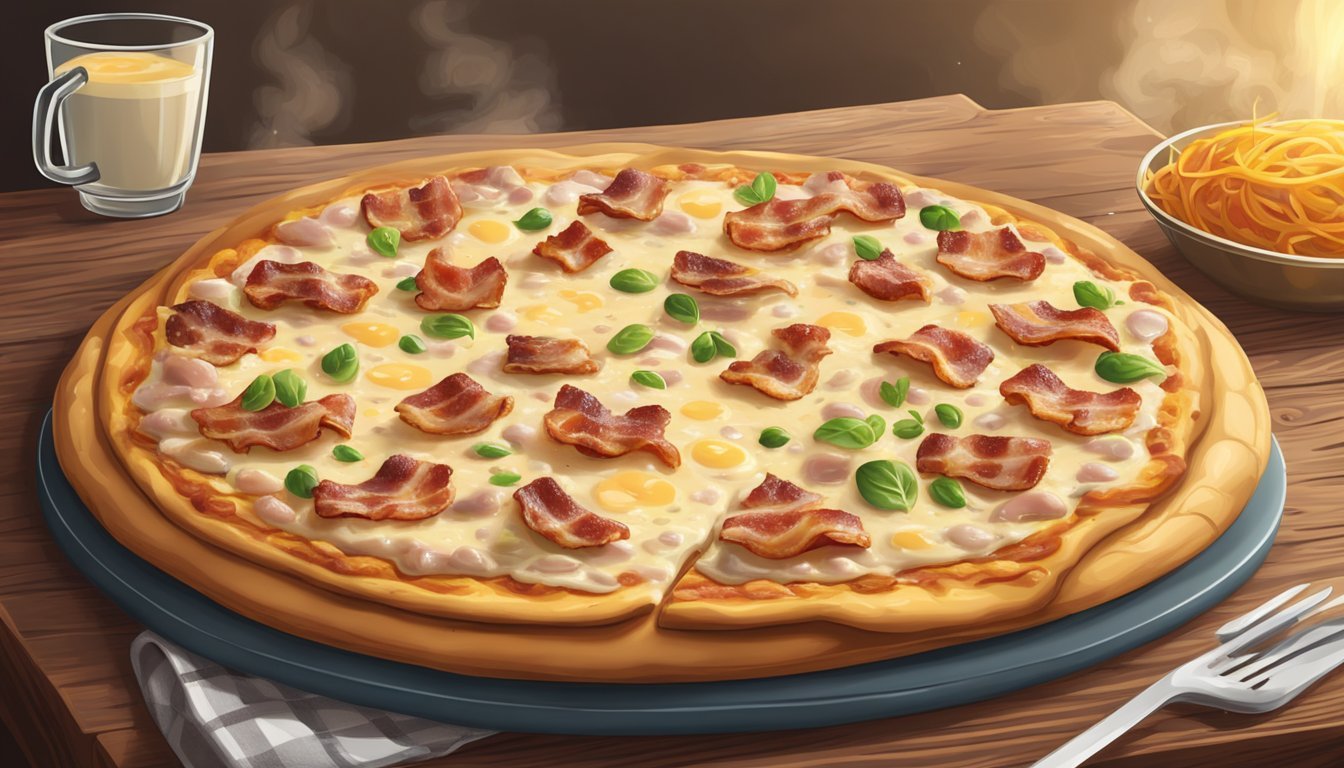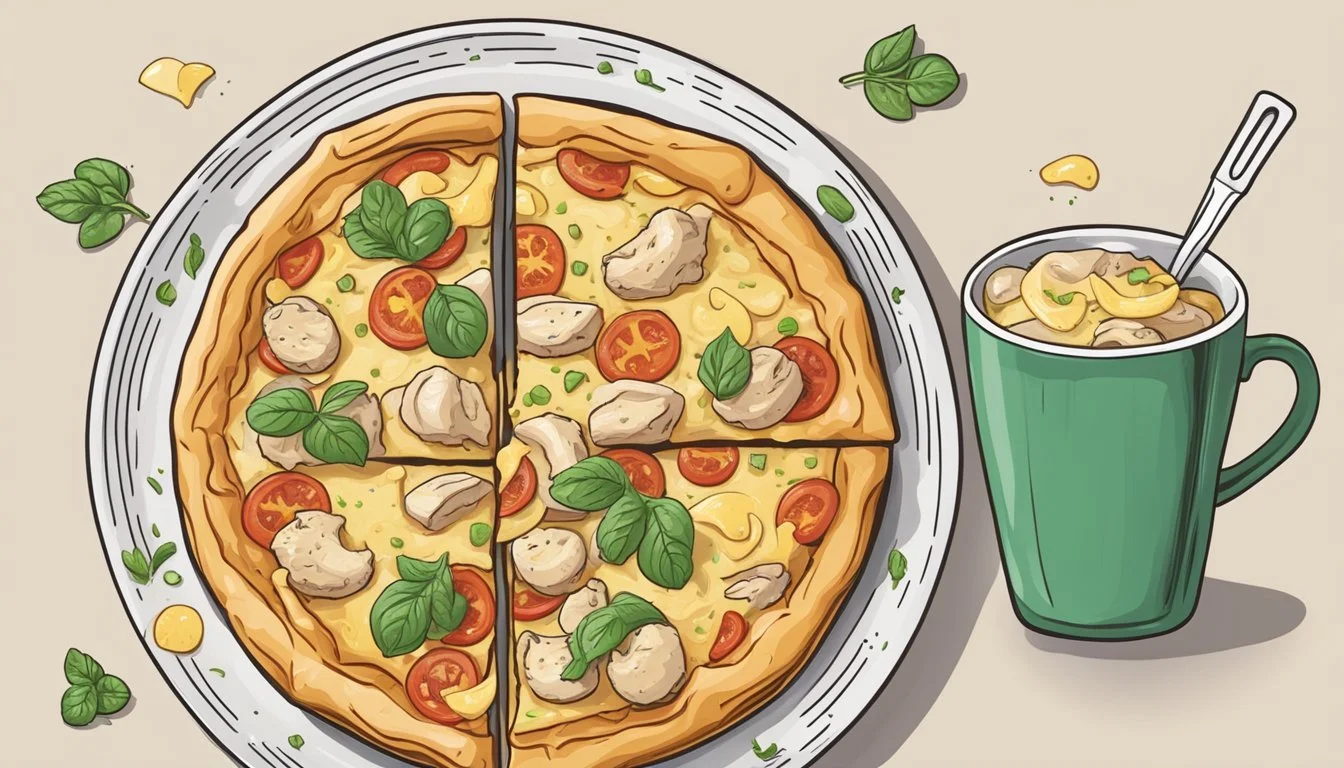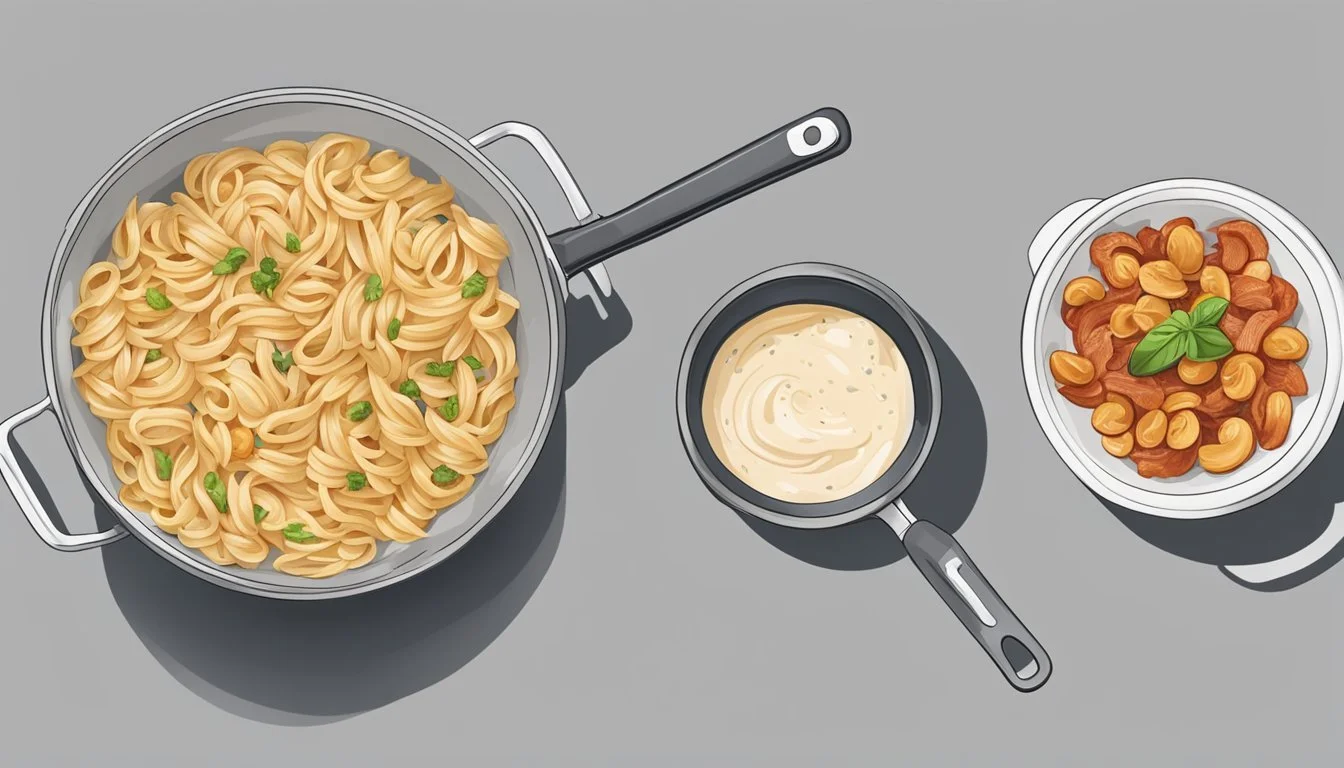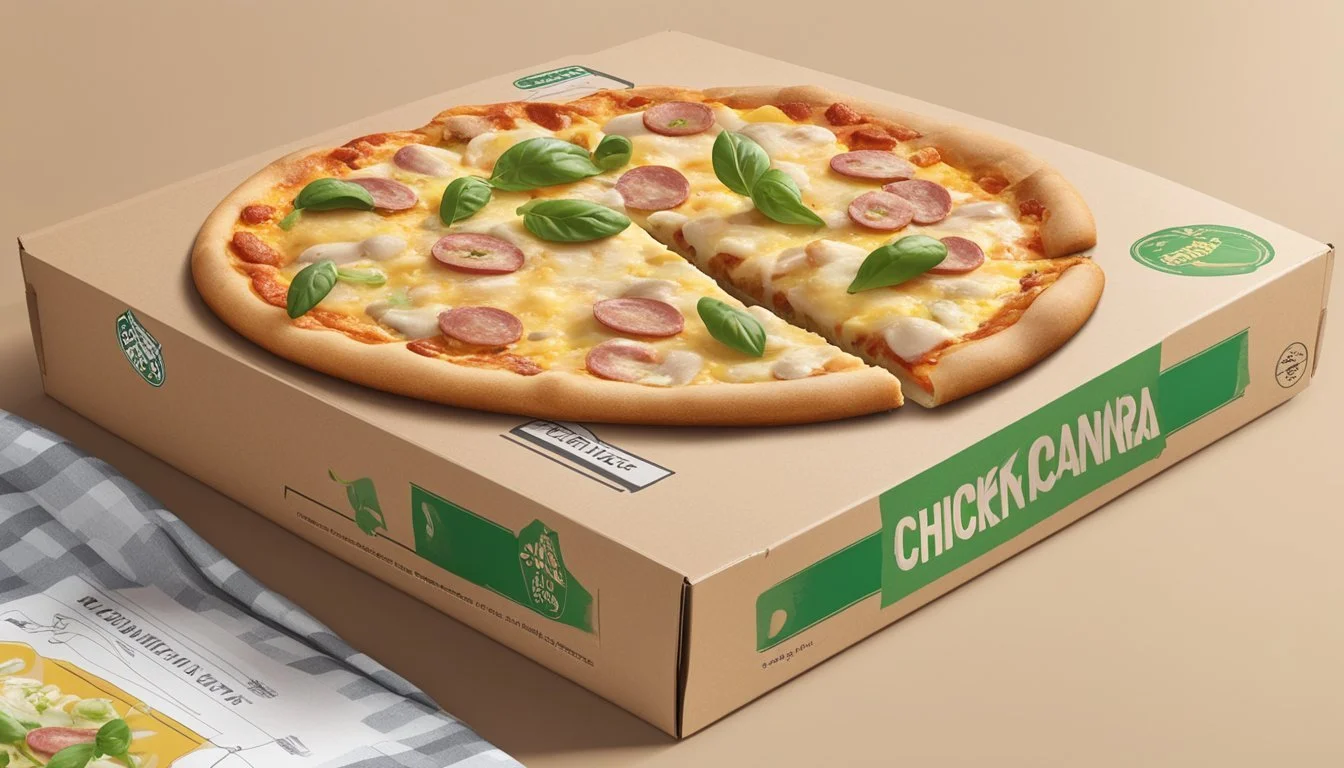Is Chicken Carbonara Pizza Vegan?
Unveiling the Ingredients
Typically, chicken carbonara is renowned as an Italian pasta (What wine goes well with pasta?) dish made with egg, hard cheese, pancetta, and pepper, with variations including ingredients such as cream and chicken. When exploring the fusion of this traditional dish with the beloved pizza, (What wine goes well with pizza?) a chicken carbonara pizza usually features similar ingredients incorporated into or atop a pizza crust.
However, when considering vegan dietary practices, which exclude all animal products, a traditional chicken carbonara pizza would not be suitable. Vegan adaptations of both pasta carbonara and pizza are possible, involving plant-based substitutions for chicken, cheese, and any dairy-based sauce elements, while aiming to replicate the dish's original flavors and textures.
To create a vegan version of chicken carbonara pizza, chefs may use dairy-free cheese, egg alternatives, and vegan meat substitutes, such as seasoned tofu or tempeh (What wine goes well with tempeh?), to mimic the savory taste and hearty feel of the original. Innovations in vegan cuisine often see a range of creative ingredient swaps to cater to a cruelty-free lifestyle without compromising on the indulgent essence of a carbonara pizza.
What is Chicken Carbonara Pizza?
Chicken Carbonara Pizza is a creative twist on the classic Italian pasta dish, Carbonara. This pizza variant combines the savory flavors of traditional Carbonara with the convenience and shared enjoyment that comes with a good pizza. It features a rich and creamy base, typically Alfredo sauce, and is topped with a variety of ingredients that pay homage to the original Carbonara recipe.
The key components of Chicken Carbonara Pizza are:
Chicken: Succulent pieces of chicken breast, often cooked until perfectly tender, provide a substantial protein element to the dish.
Bacon: A beloved ingredient in Carbonara, bacon adds a salty crunch, enhancing the pizza with its smokiness.
Cheese: Generously sprinkled atop, the cheese melts during baking, creating a gooey texture and adding depth to the flavor profile.
Garlic: Mince garlic lends an aromatic quality to the pizza, echoing the traditional pasta dish's use of garlic for depth and warmth.
Eggs: Occasionally, the pizza may feature a lightly cooked egg element, nodding to the raw eggs that are characteristic in authentic Carbonara sauce.
Some recipes may also include:
Black Pepper: A dash of freshly ground black pepper introduces a slight heat and earthiness.
Cream: Although not classic to Carbonara, some pizza recipes use cream to achieve an even creamier sauce base.
The pizza crust serves as the foundation, replacing the usual pasta, while the toppings are carefully selected to mimic the flavors of Carbonara. It's important to note, however, that Chicken Carbonara Pizza contains chicken and other non-vegan items such as cheese and bacon, making it unsuitable for a vegan diet.
Defining Veganism
Veganism is a dietary and lifestyle choice characterized by the exclusion of all animal products. Individuals who follow a vegan diet abstain from consuming meat, dairy, eggs, and any other substances derived from animals. The essence of veganism is rooted in a philosophy that rejects the commodification of animals.
The vegan diet is exclusively plant-based, encompassing a wide variety of fruits, vegetables, grains, nuts, and seeds. Vegans get their nutrients from these plant sources rather than traditional animal-based foods. Below is a breakdown of typical animal products and their vegan alternatives:
Animal Product Vegan Substitute Meat Plant-based meats Dairy Nut and soy milks Eggs Flax or chia seeds
The practice of veganism extends beyond the plate as well. Vegans typically avoid using products made from animals such as leather and wool, as well as products tested on animals.
It is important to note that veganism is a personal commitment and can vary in strictness. Some individuals may choose a vegan lifestyle for health reasons, while others may drive their decisions by environmental concerns or animal rights.
This dietary pattern has gained popularity over the years, with a surging variety of vegan products now available in the market, including meat and cheese substitutes that aim to replicate the flavors and textures of their animal-based counterparts without the use of any animal products.
Ingredients in Traditional Carbonara
Traditional Carbonara is a rich, flavorful Italian pasta dish known for its creamy texture and hearty ingredients. A true Carbonara is characterized by a few key components, each contributing to the dish's classic taste.
Pasta Base
The foundation of any Carbonara dish is the pasta. Generally, spaghetti is the pasta of choice, although other forms like fettuccine, rigatoni, or bucatini can also be used. The pasta should be cooked to al dente perfection, providing the ideal texture to complement the creamy sauce.
Carbonara Sauce
The sauce in Carbonara is distinctively rich and is traditionally made without cream. Its creaminess comes from a combination of eggs and cheese—usually Pecorino Romano or Parmigiano-Reggiano. The eggs are lightly whisked and then combined with the hot pasta, cooking gently from the heat of the pasta itself. Generous amounts of black pepper are added for spice and depth of flavor.
Chicken and Bacon
While not part of the original Roman recipe, chicken has become a common addition in many variations of Carbonara, providing an extra source of protein. Bacon, on the other hand, is often substituted for the traditional Italian guanciale or pancetta, which are types of cured pork cheek and belly, respectively. When added to the sauce, the bacon lends a smoky, savory element that is key to the dish’s overall taste profile.
Understanding Vegan Substitutes
In crafting a vegan dish, one must carefully consider substitutes for meat, dairy, and flavor enhancers that bring complexity and richness to the food without the use of animal products.
Vegan Protein Sources
For vegan protein in dishes like chicken carbonara pizza, one can turn to ingredients such as mushrooms and cashews. Mushrooms offer a meaty texture, commonly used in vegan bacon preparations. Cashews, often soaked and blended, form the base for creamy sauces (What wine goes well with creamy sauces?), emulating the rich protein component traditionally provided by chicken.
Mushrooms: As a meat substitute, they provide umami and texture.
Cashews: When soaked and blended, they create a rich, protein-dense base for sauces.
Plant-Based Dairy Alternatives
Dairy products are replaced with plant-based alternatives like cashew cream or other nut-based milks. These alternatives provide the creamy texture and rich flavor expected in a carbonara sauce. Nutritional yeast is another essential substitute, offering a cheese-like flavor that is key in achieving the depth found in traditional dairy-based cheese sauces.
Nut-Based Milks: Cashew, almond, and soy milks as cream replacements.
Nutritional Yeast: Adds a cheese-like flavor to vegan dishes.
Vegan Flavor Enhancers
Vegan dishes often rely on flavor enhancers such as black salt and nutritional yeast. Black salt, known for its egg-like flavor, can contribute to the savory notes one might miss from traditional egg-based carbonara. Additionally, nutritional yeast is a powerhouse for adding a cheesy, nutty taste to plant-based dishes.
Black Salt (Kala Namak): Provides an eggy flavor, ideal in vegan egg substitute dishes.
Nutritional Yeast: Brings a cheesy and nutty profile; key in many plant-based recipes.
Creating a Vegan Carbonara
Transitioning a classic carbonara to a vegan-friendly dish involves replacing traditional ingredients like eggs, cheese, and pork with plant-based alternatives without compromising the creamy texture and rich flavor that carbonara is known for.
Vegan Carbonara Ingredients
The essential components of a vegan carbonara include:
Pasta: Choose a preferred shape, like spaghetti or fettuccine.
Vegan bacon: This can be made from tofu, tempeh, or store-bought alternatives.
Black salt (Kala Namak): Provides the egg-like flavor due to its high sulfur content.
Soy milk: Acts as a creamy base for the sauce.
Miso paste: Offers a rich umami depth.
Nutritional yeast: Gives a cheesy flavor to the dish.
A table of additional ingredients for texture and flavor enhancements:
Ingredient Role in Dish Soy sauce Adds a savory depth Apple cider vinegar Slightly acidic note Maple syrup Adds a hint of sweetness Liquid smoke Mimics the smokiness of bacon Paprika, Cumin Spices for the vegan bacon marinade
Preparing Vegan Carbonara Sauce
To prepare the sauce, one starts by blending soy milk with miso paste and nutritional yeast until smooth. This mixture serves as the creamy base. The flavor of the sauce is further enhanced with black salt, which should be added with caution due to its potent taste.
Steps for sauce:
Blend the soy milk, miso paste, and nutritional yeast until smooth.
Season the blended mixture with black salt, adjusting according to taste.
Tips for preparation:
Prioritize unsweetened soy milk to avoid unwanted sweetness in the sauce.
Gradually incorporate the black salt, tasting as you go to avoid overpowering the sauce with its strong flavor.
Transforming Pizza into a Vegan Delight
Transforming traditional pizza into a vegan delight involves creating a plant-based foundation with dough and adding a variety of flavorful toppings, including cheese alternatives that offer both taste and texture.
Vegan Pizza Dough
The base of any pizza is the dough, and for vegans, many options ensure a delightful eating experience. Vegan pizza dough typically avoids dairy and eggs. For those with additional dietary requirements, gluten-free dough can be made using a combination of gluten-free flours like rice, almond, or chickpea flour. To enhance the flavor, ingredients such as olive oil and roasted garlic can be infused into the dough before baking.
Toppings and Flavors
Once the dough is prepared, an array of plant-based toppings can elevate the pizza to new heights. Vegan cheeses have come a long way, with options based on soy, nuts, and root vegetables that melt and stretch similarly to traditional cheeses. For a robust flavor, vegan parmesan cheese made from ground nuts and nutritional yeast can be sprinkled on top. Here's a concise list of popular vegan toppings to consider:
Sauces: Tomato, pesto, or even a rich béchamel
Cheeses: Mozzarella-style shreds, vegan parmesan, ricotta alternatives
Vegetables: Artichokes, sun-dried tomatoes, bell peppers, spinach
Proteins: Marinated tofu, tempeh, meatless sausage
By choosing high-quality ingredients and combining them thoughtfully, anyone can create a vegan pizza that doesn't just mimic the original but stands out on its own merits.
Cooking Tips and Techniques
When preparing a chicken carbonara pizza that is vegan, chefs must replace both the chicken and traditional dairy ingredients to adhere to vegan standards. For the pasta element, cook it al dente to ensure it retains a pleasing texture atop the pizza. Reserve some pasta water before draining, as it can be utilized to adjust the creaminess of the vegan carbonara sauce.
Pasta Tips:
Salt the water generously for flavor.
Follow package instructions for al dente texture.
Save a cup of pasta water to enrich sauces.
To simulate the creaminess typical of carbonara, one might blend soaked cashews with non-dairy milk, garlic, and nutritional yeast. Adding a touch of liquid smoke can impart a depth that mimics the smokiness of pancetta. Vegan chefs often use tempeh, tofu, or mushroom-based ingredients to replace chicken, ensuring that they marinate these alternatives properly to infuse them with flavor.
Creating Creaminess:
Use soaked cashews for a thick, rich base.
Incorporate nutritional yeast for a cheesy note.
Liquid smoke adds a subtle, smoky undertone.
In terms of storing the vegan carbonara sauce or prepared pizza, keep them refrigerated and consume within a few days for optimal freshness.
Storing Suggestions:
Refrigerate sauce in an airtight container.
Consume pizza within 2-3 days.
Remember, accurate measurement and timing play critical roles in achieving the desired consistency and flavor when learning how to make a vegan carbonara pizza. One should always season to taste and adjust based on personal preference, while staying true to the classic carbonara profile.
Nutritional Information
When assessing whether chicken carbonara pizza is vegan, it's crucial to evaluate the nutritional components of the dish. A traditional chicken carbonara pizza contains several non-vegan ingredients, notably chicken, cheese, and sometimes eggs in the sauce. These ingredients contribute to the protein and fat content of the pizza, making it an option with a higher caloric density.
Calories: Chicken carbonara pizza generally has a higher caloric content due to the combination of meat, cheese, and creamy sauce.
Carbohydrates: The crust provides the bulk of the carbohydrates.
Protein: Chicken is a rich source of protein, but it is not vegan-friendly.
Fat: Cheese and any cream in the sauce contribute to the fat content.
For vegan consumers, the pizza would need a complete revision, excluding all animal-derived components:
Protein: Nutritional yeast or tofu can serve as a source of vegan protein.
Fat: Plant-based creams or cheeses, made from nuts or soy, offer an alternative to traditional animal fats.
Fiber: A whole-grain crust can increase the fiber content.
Sugar: Be aware of added sugars in sauces or dough.
In summary, a pizza with "carbonara" in its name typically suggests non-vegan ingredients that influence its nutritional profile. A vegan version would forego chicken, dairy cheeses, and eggs, instead incorporating plant-based proteins and dairy alternatives, altering the nutritional facts significantly.
Food Allergies and Dietary Restrictions
When considering whether chicken carbonara pizza is suitable for vegans and those with dietary restrictions, it is important to understand the common allergens and ingredients that may conflict with these dietary needs.
Dairy-Free: Traditional chicken carbonara pizza contains cheese and often a cream-based sauce, making it unsuitable for individuals who are dairy-free due to lactose intolerance or a milk allergy. For a pizza to be dairy-free, all components including the sauce, cheese, and crust must contain no dairy.
Nut-Free: While nuts are not a standard ingredient in chicken carbonara pizza, caution should be exercised for those with nut allergies, as cross-contaminant risks are present if nuts are handled in the same kitchen.
Soy-Free: Soy allergies require avoidance of soy-based products. Soy can appear in various forms, such as soy flour in the crust or soy protein as a meat substitute. Hence, one must confirm the absence of soy in all ingredients.
Gluten-Free: A classic pizza crust is made from wheat flour, containing gluten. Individuals with celiac disease or gluten sensitivity must opt for a crust made from gluten-free alternatives like rice or almond flour.
Allergies: Food allergies can pose serious risks. Ingredients in a chicken carbonara pizza may include common allergens such as eggs, milk, wheat, and soy. Vegan adaptations of this pizza might utilize ingredients like legumes, seeds, or nuts, which are also potential allergens.
Individuals with food allergies or dietary restrictions are advised to carefully review ingredient information and confirm preparation practices with the food provider. Vegan pizzas can be tailored to exclude animal products and certain allergens, but due diligence by the consumer is essential to ensure safety and compliance with their dietary needs.
Recipe Sharing and Social Proof
When food enthusiasts transform a classic like chicken carbonara pizza into a vegan dish, sharing their creations on platforms such as Instagram has become the norm. These culinary pioneers showcase their recipes, attracting both the vegan community and those curious about plant-based alternatives. Instagram serves as a potent vehicle for social proof, reinforcing the idea that veganizing traditional comfort food is not only possible but also delicious.
A typical recipe card shared on social media includes a photo of the finished dish, a list of ingredients, and short, clear instructions. For instance, a vegan chicken carbonara pizza might feature a visual guide to creating the dairy-free sauce, selection of plant-based chicken, and the preparation of vegan cheese. This format is easy to follow and encourages home cooks to attempt the recipe themselves.
One can often find evidence of successful veganizing attempts in the comments section, where users share tweaks, substitutions, and compliments. Such interactions contribute to a recipe's credibility and highlight the versatility of vegan cooking. They also affirm that dishes recognized as comfort food can maintain their essence even after the removal of animal products.
Below is an example of how social proof and recipe sharing manifest in the vegan community:
Photo: Mouth-watering image of the vegan pizza.
Likes & Comments: Enthusiastic feedback and questions about the dish.
Tags: #VeganComfortFood, #VeganPizza, #RecipeShare.
Instructions: Brief, step-by-step guide for recreating the dish.
The combined influence of visual appeal, peer reviews, and ease of replication contributes to the popularity and acceptance of vegan recipes in the mainstream, establishing them as a staple in modern-day comfort food.
Conclusion
Chicken carbonara pizza typically includes ingredients such as chicken, bacon, cheese, and eggs, which are not vegan. To adapt a chicken carbonara pizza for a vegan diet, one needs to substitute these non-vegan items with plant-based alternatives.
A vegan carbonara recipe might utilize a variety of replacements. For the "bacon" component, one could use marinated and baked tofu or tempeh with soy sauce, liquid smoke, and maple syrup for flavor. As for the cheese and eggs that create the creamy sauce, a blend of cashews, nutritional yeast, soy or almond milk, and black salt (kala namak) for the eggy flavor can be employed.
Moreover, these adaptations can be part of a satisfying weeknight meal that offers both nutrition and comfort. Vegan carbonara pizza can retain the flavor profile and creamy texture associated with the original dish, making it suitable as comfort food.
To summarize, the conversion of a classic chicken carbonara pizza into a vegan-friendly version is possible with available vegan substitutes that mimic the textures and flavors of the original ingredients. This approach allows vegans to enjoy a beloved dish without compromising their dietary choices.













